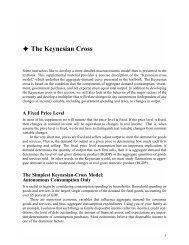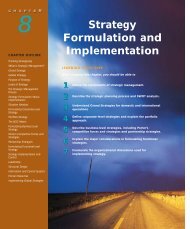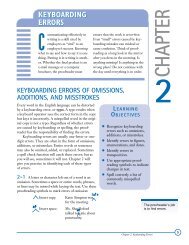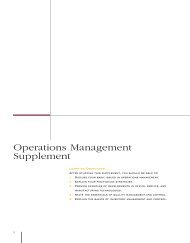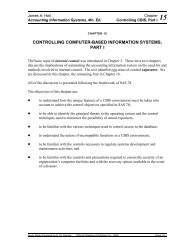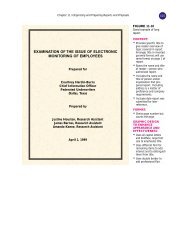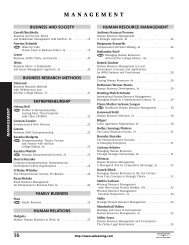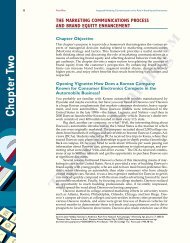REPLACEMENT PROJECT ANALYSIS
REPLACEMENT PROJECT ANALYSIS
REPLACEMENT PROJECT ANALYSIS
Create successful ePaper yourself
Turn your PDF publications into a flip-book with our unique Google optimized e-Paper software.
App11B_SW_Brigham_778312_R2 1/6/03 9:12 PM Page 11B-5<br />
11B-2<br />
Replacement analysis<br />
11B-3<br />
Replacement analysis<br />
11B-4<br />
Replacement analysis<br />
11B-5<br />
Replacement analysis<br />
Dauten is offered a replacement machine which has a cost of $8,000, an estimated useful<br />
life of 6 years, and an estimated salvage value of $800. This machine falls into the MACRS<br />
5-year class so the applicable depreciation rates are 20 percent, 32 percent, 19 percent, 12 percent,<br />
11 percent, and 6 percent. The replacement machine would permit an output expansion,<br />
so sales would rise by $1,000 per year; even so, the new machine’s much greater efficiency<br />
would still cause operating expenses to decline by $1,500 per year. The new machine would<br />
require that inventories be increased by $2,000, but accounts payable would simultaneously increase<br />
by $500. Dauten’s marginal federal-plus-state tax rate is 40 percent, and its cost of capital<br />
is 15 percent. Should it replace the old machine?<br />
The Chang Company is considering the purchase of a new machine to replace an obsolete<br />
one. The machine being used for the operation has both a book value and a market value of<br />
zero; it is in good working order, however, and will last physically for at least another<br />
10 years. The proposed replacement machine will perform the operation so much more efficiently<br />
that Chang engineers estimate it will produce after-tax cash flows (labor savings and<br />
depreciation) of $9,000 per year. The new machine will cost $40,000 delivered and installed,<br />
and its economic life is estimated to be 10 years. It has zero salvage value. The firm’s cost<br />
of capital is 10 percent, and its marginal tax rate is 35 percent. Should Chang buy the new<br />
machine?<br />
Mississippi River Shipyards is considering the replacement of an 8-year-old riveting machine<br />
with a new one that will increase earnings before depreciation from $27,000 to $54,000 per<br />
year. The new machine will cost $82,500, and it will have an estimated life of 8 years and no<br />
salvage value. The new machine will be depreciated over its 5-year MACRS recovery period<br />
so the applicable depreciation rates are 20 percent, 32 percent, 19 percent, 12 percent, 11 percent,<br />
and 6 percent. The applicable corporate tax rate is 40 percent, and the firm’s cost of capital<br />
is 12 percent. The old machine has been fully depreciated and has no salvage value. Should<br />
the old riveting machine be replaced by the new one?<br />
The Erley Equipment Company purchased a machine 5 years ago at a cost of $100,000. The<br />
machine had an expected life of 10 years at the time of purchase, and an expected salvage value<br />
of $10,000 at the end of the 10 years. It is being depreciated by the straight-line method toward<br />
a salvage value of $10,000, or by $9,000 per year.<br />
Anew machine can be purchased for $150,000, including installation costs. During its 5year<br />
life, it will reduce cash operating expenses by $50,000 per year. Sales are not expected<br />
to change. At the end of its useful life, the machine is estimated to be worthless. MACRS<br />
depreciation will be used, and the machine will be depreciated over its 3-year class life<br />
rather than its 5-year economic life so the applicable depreciation rates are 33 percent, 45 percent,<br />
15 percent, and 7 percent.<br />
The old machine can be sold today for $65,000. The firm’s tax rate is 35 percent. The appropriate<br />
discount rate is 16 percent.<br />
a. If the new machine is purchased, what is the amount of the initial cash flow at Year 0?<br />
b. What incremental operating cash flows will occur at the end of Years 1 through 5 as a result<br />
of replacing the old machine?<br />
c. What incremental terminal cash flow will occur at the end of Year 5 if the new machine is<br />
purchased?<br />
d. What is the NPV of this project? Should Erley replace the old machine?<br />
The Bigbee Bottling Company is contemplating the replacement of one of its bottling machines<br />
with a newer and more efficient one. The old machine has a book value of $600,000 and<br />
a remaining useful life of 5 years. The firm does not expect to realize any return from scrapping<br />
the old machine in 5 years, but it can sell it now to another firm in the industry for<br />
$265,000. The old machine is being depreciated toward a zero salvage value, or by $120,000<br />
per year, using the straight-line method.<br />
The new machine has a purchase price of $1,175,000, an estimated useful life and MACRS<br />
class life of 5 years, and an estimated salvage value of $145,000. The applicable depreciation<br />
rates are 20 percent, 32 percent, 19 percent, 12 percent, 11 percent, and 6 percent. It is expected<br />
to economize on electric power usage, labor, and repair costs, as well as to reduce the number of<br />
defective bottles. In total, an annual savings of $255,000 will be realized if the new machine is<br />
installed. The company’s marginal tax rate is 35 percent and it has a 12 percent cost of capital.<br />
a. What is the initial cash outlay required for the new machine?<br />
b. Calculate the annual depreciation allowances for both machines, and compute the change<br />
in the annual depreciation expense if the replacement is made.<br />
APPENDIX 11B ■ <strong>REPLACEMENT</strong> <strong>PROJECT</strong> <strong>ANALYSIS</strong><br />
11B-5



